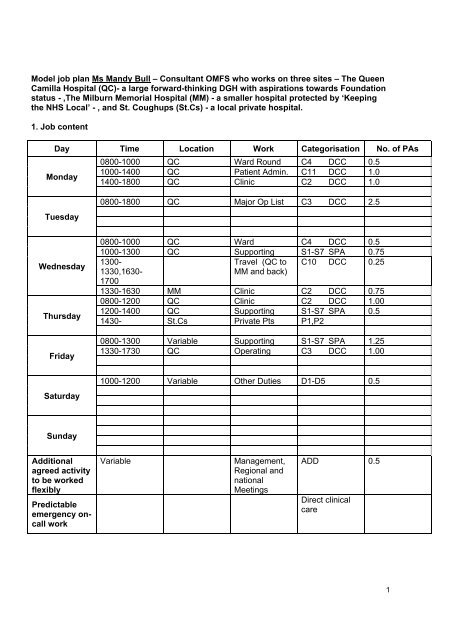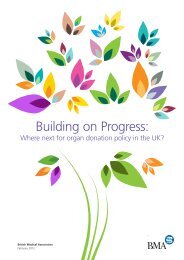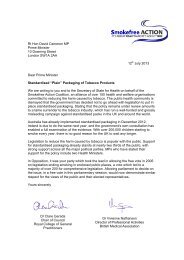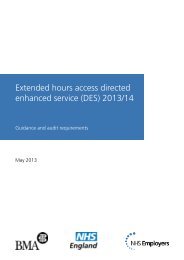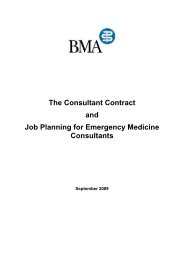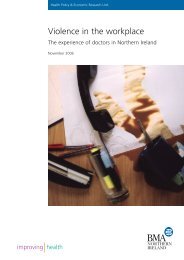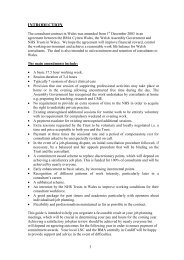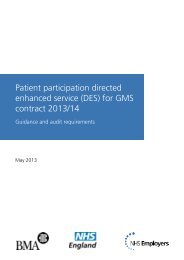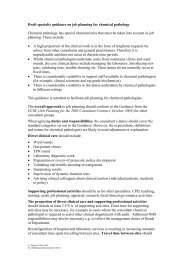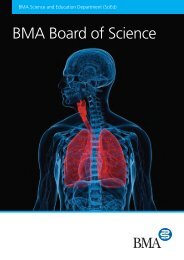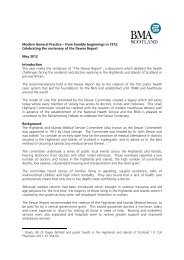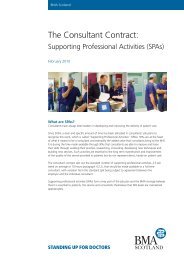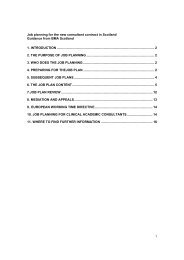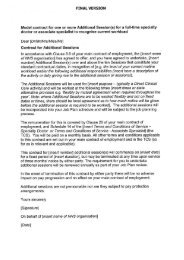Model job plan Ms Mandy Bull – Consultant OMFS who works ... - BMA
Model job plan Ms Mandy Bull – Consultant OMFS who works ... - BMA
Model job plan Ms Mandy Bull – Consultant OMFS who works ... - BMA
Create successful ePaper yourself
Turn your PDF publications into a flip-book with our unique Google optimized e-Paper software.
<strong>Model</strong> <strong>job</strong> <strong>plan</strong> <strong>Ms</strong> <strong>Mandy</strong> <strong>Bull</strong> <strong>–</strong> <strong>Consultant</strong> <strong>OMFS</strong> <strong>who</strong> <strong>works</strong> on three sites <strong>–</strong> The Queen<br />
Camilla Hospital (QC)- a large forward-thinking DGH with aspirations towards Foundation<br />
status - ,The Milburn Memorial Hospital (MM) - a smaller hospital protected by ‘Keeping<br />
the NHS Local’ - , and St. Coughups (St.Cs) - a local private hospital.<br />
1. Job content<br />
Day Time Location Work Categorisation No. of PAs<br />
0800-1000 QC Ward Round C4 DCC 0.5<br />
Monday<br />
1000-1400<br />
1400-1800<br />
QC<br />
QC<br />
Patient Admin.<br />
Clinic<br />
C11<br />
C2<br />
DCC<br />
DCC<br />
1.0<br />
1.0<br />
Tuesday<br />
Wednesday<br />
Thursday<br />
Friday<br />
Saturday<br />
Sunday<br />
Additional<br />
agreed activity<br />
to be worked<br />
flexibly<br />
Predictable<br />
emergency oncall<br />
work<br />
0800-1800 QC Major Op List C3 DCC 2.5<br />
0800-1000 QC Ward C4 DCC 0.5<br />
1000-1300 QC Supporting S1-S7 SPA 0.75<br />
1300-<br />
Travel (QC to C10 DCC 0.25<br />
1330,1630-<br />
1700<br />
MM and back)<br />
1330-1630 MM Clinic C2 DCC 0.75<br />
0800-1200 QC Clinic C2 DCC 1.00<br />
1200-1400 QC Supporting S1-S7 SPA 0.5<br />
1430- St.Cs Private Pts P1,P2<br />
0800-1300 Variable Supporting S1-S7 SPA 1.25<br />
1330-1730 QC Operating C3 DCC 1.00<br />
1000-1200 Variable Other Duties D1-D5 0.5<br />
Variable Management,<br />
Regional and<br />
national<br />
Meetings<br />
ADD 0.5<br />
Direct clinical<br />
care<br />
1
Unpredictable<br />
emergency oncall<br />
work<br />
TOTAL PAs<br />
Variable<br />
On-site, at home<br />
on the telephone<br />
and travelling to<br />
and from site<br />
Direct clinical<br />
care<br />
Programmed activity Number<br />
Direct clinical care (including unpredictable on-call) 8.5<br />
Supporting professional activities 2.5<br />
Other NHS responsibilities 0.5<br />
External duties 0.5<br />
TOTAL PROGRAMMED ACTIVITIES 12<br />
Notes<br />
(a) There are four time blocks set out for each day. Not all blocks need to be filled in. It is<br />
feasible that consultants will have 1,2, 3 or even more PAs on any one day.<br />
(b) Under ‘additional agreed activity’ the consultant might agree, for example, with the employer<br />
that they will undertake a certain proportion of regular patient administration equating to x<br />
PAs, at an unspecified time and location during the week. This section might also be used to<br />
set out the number of PAs for any unpredictable external duties.<br />
(c) Predictable on-call work: where this work follows a regular pattern each week, consultants<br />
should identify within the weekly schedule when and where this takes place. Where such<br />
work does not follow a regular pattern, for example due to the variability of the on-call rota,<br />
consultants should assess an average level of activity per week and identify it in the<br />
predictable activity box at the bottom of the form.<br />
(d) The location and timing of unpredictable emergency work cannot be completed, therefore<br />
only the categorisation and number of PAs should be completed.<br />
(e) Location can be the principal place of work or any other agreed location e.g. the consultant’s<br />
home for some duties.<br />
(f) In the ‘work’ column, a description of the duty should be completed, e.g. outpatient clinic,<br />
ward round, operating list.<br />
(g) The ‘categorisation’ column should define whether the work is direct clinical care, supporting<br />
professional activity, additional NHS responsibility or external duty.<br />
(h) The number of PAs should specify the number of PAs allocated to the duty. This can be a full<br />
PA or broken down into smaller units. If the work is in premium time after 1 April 2004, 3<br />
hours of work is one programmed activity.<br />
(i) Regular private practice commitments should be identified broadly in terms of timing, location<br />
and type of work.<br />
(j) In addition to regular duties and commitments, the consultant might have certain ad-hoc<br />
responsibilities. These would normally but not exclusively fall into the ‘additional NHS<br />
responsibilities’ or ‘external duties’ categories of work, for example member of an Advisory<br />
Appointments Committee or work for a Royal College. Such duties could be scheduled or<br />
agreement could be reached to deal with such work flexibly (see section 5 below).<br />
2
2. On-call availability supplement<br />
Agreed on-call rota e.g. 1 in 5:<br />
Agreed category (delete):<br />
On-call supplement e.g. 5%:<br />
3. Objectives<br />
Objectives and how they will be met<br />
1. Continue to provide high quality emergency services (with the necessary support<br />
available).<br />
2. Sustain local Trust Objectives where adequately resourced.<br />
3. Continue teamworking (MDT, networking etc)<br />
4. Participate in audit and clinical governance at local and other levels.<br />
5. Work with management to sustain local activity in the light of other pressures.<br />
4. Supporting resources<br />
Facilities and resources<br />
required for delivery of duties<br />
and objectives<br />
1. Staffing support<br />
2. Accommodation<br />
3. Equipment<br />
4. Any other required resources<br />
No. of colleagues on<br />
published rota<br />
Continued availability of access to ITU, Ward, and<br />
Ambulatory care beds. Some degree of agreed flexibility<br />
to maintain a balanced service to all aspects of NHS<br />
needs.<br />
Recruit additional ward staff. Ensure where possible<br />
continued recruitment to <strong>OMFS</strong> with expansion of SpR<br />
grade.<br />
A / B<br />
Ensure out-patient and ambulatory care facilities are<br />
appropriately funded with sufficient clinic and office<br />
accommodation. Improve staff residencies.<br />
Ensure adequate funding to maintain/update essential<br />
operating dept. items.<br />
Increase secretarial support in the light of continued<br />
and expanding need (Clin. Governance, Audit, Protocols<br />
etc.)<br />
3
6. Additional NHS responsibilities and/or external duties<br />
Specify how any responsibilities or duties not scheduled within the normal timetable will be dealt with<br />
Following local agreement to ensure that service is maintained and other colleagues not unduly burdened.<br />
Other agreements<br />
Note: In addition to regular duties and commitments, the consultant might have certain ad-hoc<br />
responsibilities. These would normally but not exclusively fall into the ‘additional NHS<br />
responsibilities’ or ‘external duties’ categories of work, for example member of an Advisory<br />
Appointments Committee or work for a Royal College. Such duties could be scheduled or<br />
agreement could be reached to deal with such work flexibly. The method of dealing with such<br />
commitments should be set out in the box above.<br />
6. Other comments or agreements<br />
Detail any other specific agreements reached about how the <strong>job</strong> <strong>plan</strong> will operate. For example, with<br />
regard to category 2 fees, domiciliary consultations and location flexibility.<br />
7. Additional programmed activities<br />
a. Are you undertaking private medical practice as defined in the terms<br />
Yes<br />
of service?<br />
b. If yes, are you already working an additional programmed activity<br />
Yes<br />
above your main commitment?<br />
c. If no, has the trust offered an additional programmed activity this<br />
N/A<br />
year?<br />
d. If yes, has this been taken up? N/A<br />
e. If no, have other acceptable arrangements been made (e.g. taken<br />
up by a colleague)?<br />
If yes to (e) please describe:<br />
…………………………………………………………………………………………………………………<br />
…………………………………………………………………………………………………………………<br />
N/A<br />
4
8. Signed off and agreed<br />
<strong>Consultant</strong> name …………………………………………………..<br />
Signed (consultant) …………………………………………………..<br />
Date …………………………………………………..<br />
Clinical manager …………………………………………………..<br />
Signed (clinical manager) …………………………………………………..<br />
Date …………………………………………………..<br />
5
ADDITIONAL NOTES TO HELP <strong>OMFS</strong> COLLEAGUES WHEN COMPLETING JOB PLANS<br />
1. The attached draft <strong>job</strong> <strong>plan</strong> is certainly not meant to be exclusive and is merely an<br />
attempt to represent a reasonable spread of activity for an <strong>OMFS</strong> colleague. It is<br />
accepted that there will be wide individual variation but an attempt should be made to<br />
ensure that the proportions of 7.5 for clinical care to 2.5 of supporting activity is broadly<br />
maintained.<br />
2. Although that the enclosed draft shows the working day starting at 0800 hours it is<br />
accepted that this may well not be the norm, but a later start will of course generally<br />
mean a later finish in order to make up the hours.<br />
3. <strong>OMFS</strong> colleagues are also reminded that on completion of the <strong>job</strong> <strong>plan</strong> they will need to<br />
agree seniority (i.e., years in post) and time taken for a second primary degree can now<br />
be included (if this has not already been assessed on appointment) see page 30, para 6.<br />
4. Care should be taken when choosing the incremental date. This will normally be 1 st April<br />
2003, but as seniority is reckoned in <strong>who</strong>le years it may be beneficial to agree a later<br />
incremental date (foregoing any additional remuneration in the intervening months) as<br />
this may mean that the next pay threshold more quickly (see the Ready Reckoner on the<br />
<strong>BMA</strong> website).<br />
5. Although PAs in excess of 10 are not pensionable the draft new contract does say<br />
“Pensionable pay… and any other pay expressly agreed to be pensionable”. Colleagues<br />
may wish to bear this in mind when negotiating and certainly if previously they have been<br />
paying superannuation on additional remunerated sessions (e.g., managerial<br />
commitments).<br />
6. The inclusion of lunchtime in the assessment of PAs is a matter for local and personal<br />
judgement. Certainly on days where it is not possible to have a short break this time<br />
should be counted.<br />
7. On-call availability supplements will vary with frequency and intensity.<br />
8. Assessment of predictable and unpredictable will vary between Units but if, for instance,<br />
you routinely have a Saturday morning ward round following a night on-take this can be<br />
assessed as the number of hours spent at premium time divided by the rota frequency to<br />
give a weekly assessment of PAs. Remember that as from 1 st April 2004 premium time<br />
is assessed as 3 hours.<br />
9. Remember, you are not obliged to undertake more than 10 PAs, unless you wish to do<br />
so, and some would suggest that you would be in a strong position to negotiate an<br />
enhanced rate for PAs in excess of 11. This will no doubt be a matter for local LNCs.<br />
10. Under the European Working Time Directive (EWTD) employees are not meant to work<br />
for more than 6 hours without a 20 min break. If say 20 or 30 mins are taken for lunch,<br />
then it should be made clear that you are not available to do any NHS activity apart from<br />
dealing with clinical emergencies and may be off the premises. Alternatively, many of us<br />
are available for management meetings, give advice to trainees, take phone calls in<br />
relation to NHS work at the same time as eating a sandwich. Under these<br />
circumstances, lunch should be included within the working day. However, management<br />
cannot have it both ways i.e. expect consultants to be available for meetings or other<br />
NHS activity within unpaid lunch breaks.<br />
6
11. Under the new contract the maximum part-time option is gone (for those that switch<br />
across) and therefore there is no travelling time into the base hospital. Travelling time<br />
can be claimed for travelling to peripheral centres from base and also the excess<br />
travelling time (i.e. travel time less time to base) when travelling from home to a<br />
peripheral centre. This comes out of the Direct Patient Care PAs.<br />
12. Many consultants will work more than 11 PAs and some less. Some management has<br />
said they will not pay more than 12 PAs, as this is the maximum under the EWTD. This<br />
is not true <strong>–</strong> they can pay more than 12 provided consultants opt out on an annual basis<br />
of the protection of the EWTD. This facility may not last much longer, as the EWTD is<br />
meant to be health and safety legislation for employees. <strong>Consultant</strong>s can also work more<br />
than 12 PAs and still be compliant with the 48-hour weekly limit provided some of the<br />
PAs are undertaken in premium time and are only 3 hours long.<br />
13. The EWTD does not apply to self-employment. You cannot therefore be told that if you<br />
offer 11 PAs to the Trust that means that you can only work 4 hours in private practice.<br />
In other words, if you want to kill yourself doing additional work in private practice that is<br />
up to you but you must turn up for work able to do the <strong>job</strong> you are paid for.<br />
14. Do not agree to less than 2.5 PAs for supporting activities <strong>–</strong>for many in our specialty 3<br />
PAs will be reasonable provided they can be justified on the <strong>job</strong> <strong>plan</strong>.<br />
Remember all the administration related to patient care must now come out of the Direct Patient<br />
Care PAs. This includes <strong>plan</strong>ning for surgery, discussing joint management of cases with<br />
colleagues, reporting radiographs, as well as dictating letters etc.<br />
7


